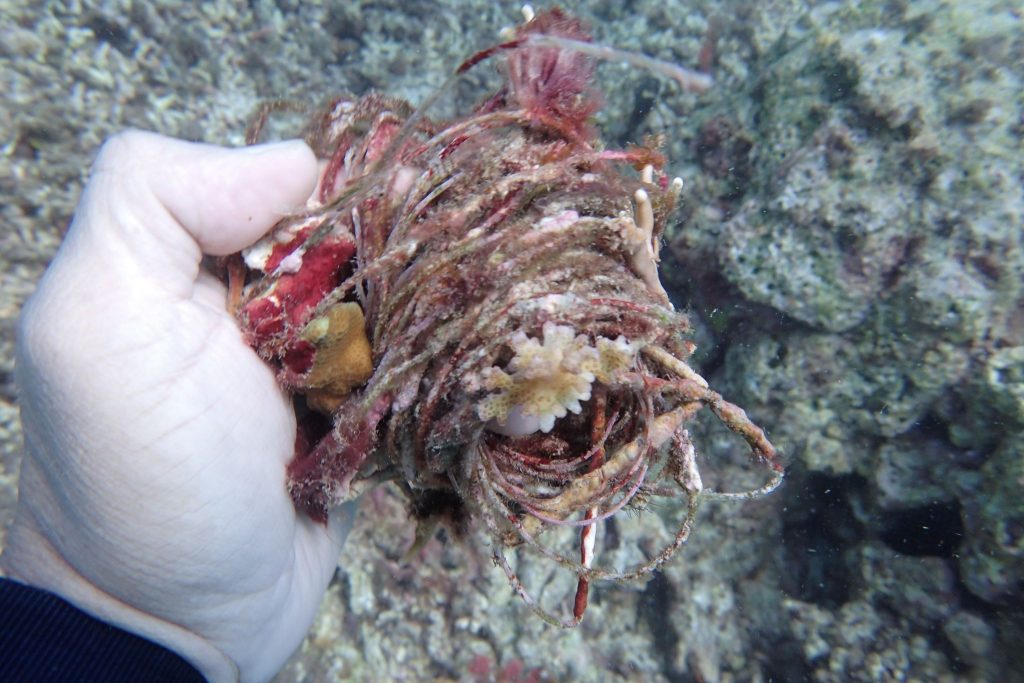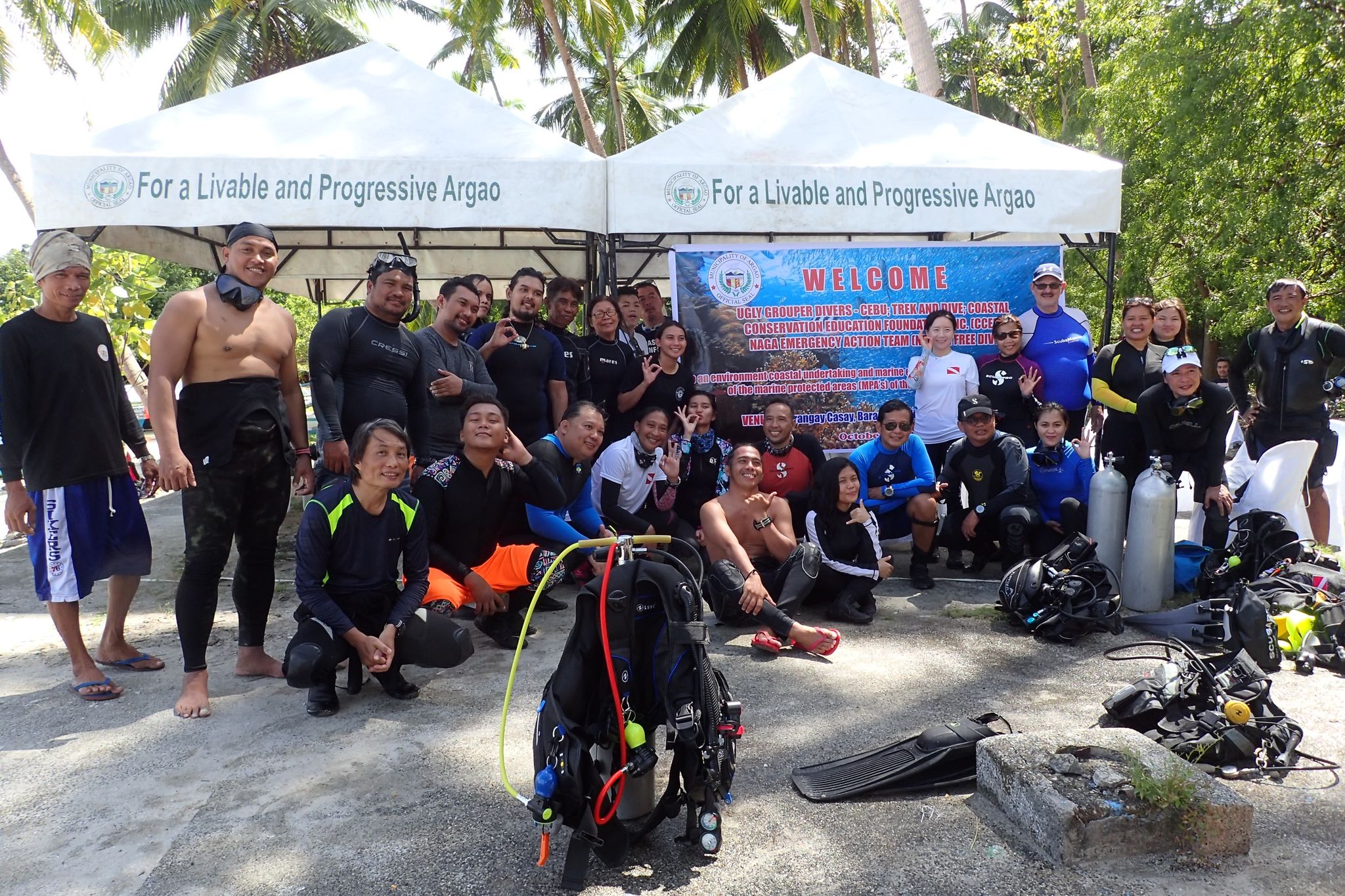October 17, 2020- CCEF together with 62 partner divers from UGLY Grouper – Scuba Divers, TREK & DIVE and divers from Naga held another underwater cleanup at Barangay Casay, Argao, Cebu.
-

-

-

-

Tulic and Casay Reef, Argao. Photos by Tim Consul of UGLY Group Scuba Divers.
At first glance, Tulic and Casay Reef boast of a beautiful reef formation with pristine waters that’s free from trash. But upon exploring the reef you will find most of the corals to be either broken into small pieces, entangled with several nylon fishing lines, and with almost no fishes. According to the local Bantay Dagat, at least seven compressor fishing vessels were apprehended at Casay and Tulic Reef, most of them were noted to be Badjaos from Bohol. It is also noticeable in the reef that Nylon lines are still being tied to coral branches, causing many corals to break.
-

-

-

-

Weighted Stones and Metal Bars -

-

Nylon tied to coral branches -

Nylon lines -

Weighted stones used in Seroska
Most of the trash in Tulic reef were nylon fishing lines and discarded weighted stones/ metal bars commonly used for scaring fish and breaking corals in a method called “seroska”; a form of muro-ami utilizing stones to make a banging sound by hitting corals and driving fishes towards their fish nets.
In Casay reef, the team of divers were able to collect a large bundle of discarded nylon lines with water bottles as floaters and used tires for anchoring red algae (Euchema “guso”)farming.
Based on the previous CCEF MPA Management Assessment Conducted in Aragao last march, All Marine Protected Areas in Argao are currently at level 1 and needs more improvement especially in terms of enforcement, organizational governance and awareness.
-

William Villaver, Ugly Grouper SCUBA Divers Marine Biologist -

Jonathan Apurado, CCEF Marine Biologist
At the end of the cleanup Dive, Marine Biologists William Villaver and Jonathan Apurado gave their insights regarding the reef including the impact of overfishing and the use of Seroka in the Marine Sanctuary.
Everytime people would ask me to explain the importance of MPAs I would tell them a story: There is a Father who would want to entertain the visitors for his son’s 1st birthday. He throws a dynamite to the ocean to gain a large fish catch. But because of what he did, his son will not be able to see those reefs in another 49 years. That is the impact of destructive and overfishing to our marine ecoysystems. Corals grow very slowly and so it is very important to protect them for our own food security,
William Villaver, Ugly Grouper SCUBA Diver Marine Biologist
“Argao’s Tulic shoal reef and its Casay shore reef are dive sites that needs rehabilitation if the communities and LGU are serious to gain tourism proceeds from these places. When the natural make-up of the coral reef rebounds to its unmolested condition people would earn more with beach users, may they be on a picnic, snorkeling, boating and many non-consumptive activities aside from scuba diving. A living and an original aquarium is a sight to behold unlike the dying, fishless and broken corals that you may encounter at present”
Jonathan Apurado, CCEF Marine Biologist
AJ Lozada and Pablita Huerbana who were also present during the cleanup dive also gave their insights and recommendations regarding the reef.
“At a glance, it is clear that the reef is in poor condition. Lots of fishing lines and tools were collected also indicates fishing activity inside the protected area. These fishing activities may even have damaged the reefs. There was an alarmingly low presence of larger fishes as well. Overall, the MPA needs to be better protected and managed. This shoal in the past was a highly recommended dive spot. It would be great if it could recover.”
AJ Lozada, CCEF Diver & IT Database Administrator
” The reef formation was beautiful and yet it was completely devoid of fishes and corals. It makes you wonder as to why their reef was at that state. It was obvious that the main cause was the lack of awareness and care by the locals for their own reef. Locals are not motivated to protect their own MPA and some of the boatmen also mentioned that it was the bantay dagat themselves who fish in the marine sanctuary. There was also no clear delienation since the buoy markers are being swept away by the ocean currents”
Pablita Huerbana, CCEF Diver, Admin and Accounting Assistant
Garbage and pollution is not the main problem of Casay and Tulic Reef, but instead overfishing, enforcement, the lack of motivation of locals to protect their own reef and the lack of proper equipment for the coastal law enforcers. In conclusion, the CCEF Team recommends the following:
1. Reconvene for a coast watch team with lifetime support in the LGU, place job items with regular wages for the key personnel with one focus job like a coast guard to act as a deterrent, and to the last recourse of apprehending any form of fishing to all protected areas. This will become their key motivator to conserve the MPA.
2. Establish and sustain communication linkages with concerned government agencies (eg.DA or DENR) and NGOs that could address or provide solutions that may transpire from the nuances of managing these MPAs.
3. Make a Business Plan for MPA management and see it through its implementation and applicable for the next political administrators and make an ordinance to strengthen and sustain the effort.
4. Create and keep social media accounts for the tourism industry to relay and promote these MPAs and encourage good practice to educate and eradicate ignorance of pollution, destructive fishing, and the importance of natural ecology.
5. Formation of an MPA Management body or an MPA reorganization. Conduct local coastal law enforcement training including buoy installation and better equipment for coastal law enforcers.
We thank all our partners, UGLY Grouper SCUBA Divers, Trek & Dive, Divers from Naga (Ex-SEAKnights) as well as the Municipality of Argao for making this activity a success. We also thank Mayor Allan Sesaldo for being supportive of the conservation of the MPAs.







